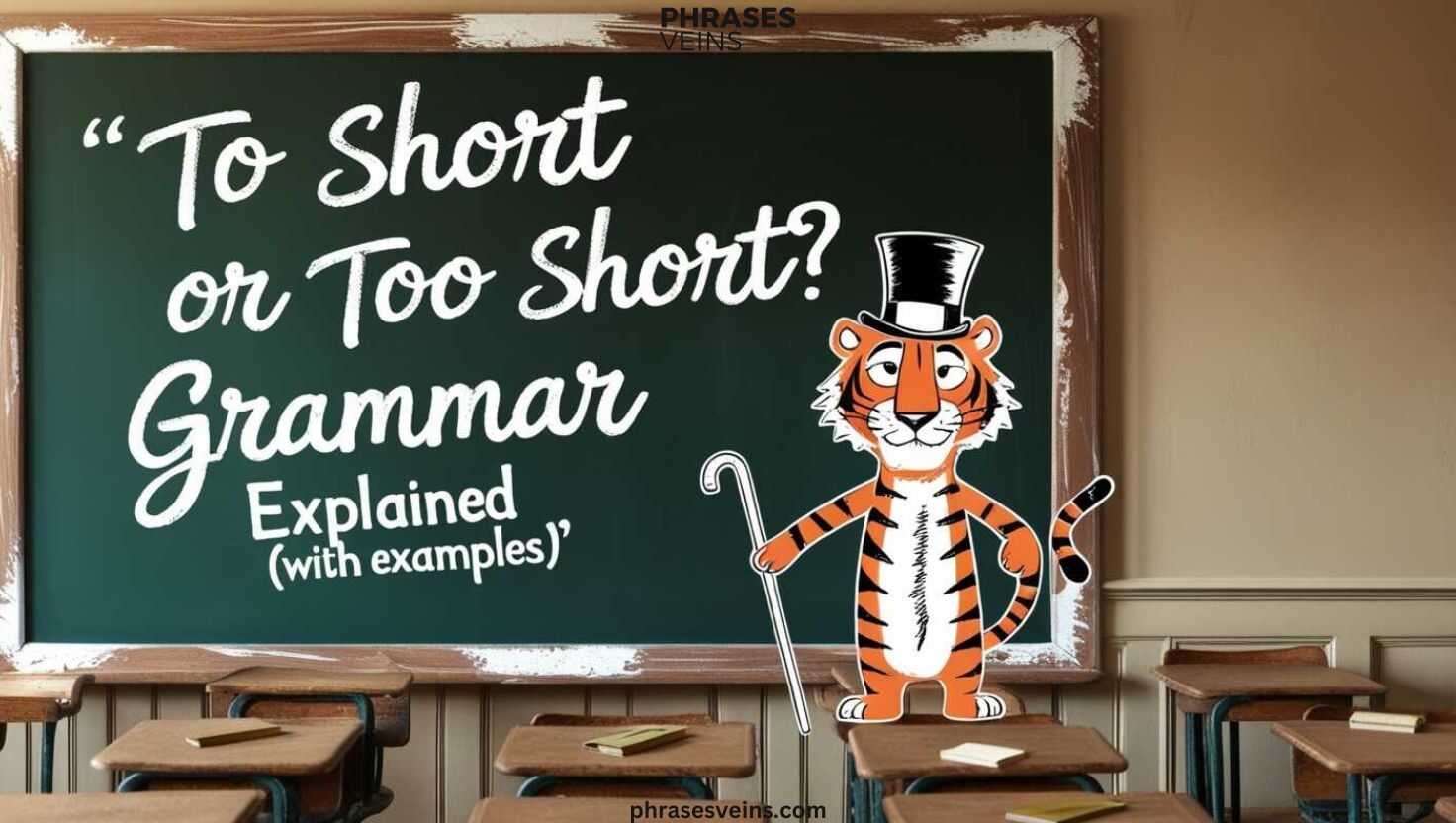Understanding grammar can be tricky. Small errors, like mixing up “to short or too short”, can cause confusion. This blog post will clarify the difference between “to” and “too”, explain common grammar mistakes, and offer examples to help you use these words correctly. Let’s dive into this grammar guide to ensure your writing accuracy improves!
To vs Too: What’s the Difference?
The confusion between “to” and “too” comes from their similar pronunciation, known as homophone confusion. Both words sound the same but have different meanings and roles.
- “To” is a preposition or part of an infinitive verb, such as “to run” or “to the park.”
- “Too” is an adverb that means “also” or “excessively.” For example, “too much” means more than needed.
Learning these English rules helps eliminate writing pitfalls and ensures correct grammar in your sentences.
The Root of the Problem
Why do people mix up “to” and “too”? One reason is the similarity in sound. This creates writing mistakes, especially for non-native speakers. Another reason is fast typing, where spell-check often misses homophones.
The good news is, with practice and simple grammar tips, you can master this difference. Keep reading to uncover how to use these words properly and avoid common errors!
Breaking Down “To” and “Too”
Understanding grammar categories like prepositions and adverbs is key.
- “To” connects words and shows direction or purpose. For instance:
- “I am going to the store.”
- “He wants to learn English.”
- “Too” emphasizes excess or adds information. For example:
- “This shirt is too big.”
- “I want to come, too.”
By focusing on their roles, you can avoid phrase confusion and ensure writing clarity.
When to Use “Too Short”
Too short usage applies when describing something that is excessively short. For example:
- “This skirt is too short for the office.”
- “His essay was too short to meet the requirements.”
The word “too” acts as a modifier, expressing excessiveness. Correct usage like this improves your sentence structure and shows a strong command of linguistic rules.
Examples in Context
Here are too short examples to help you see the difference:
| Correct Sentence | Incorrect Sentence |
|---|---|
| “The rope is too short to reach the ground.” | “The rope is to short to reach the ground.” |
| “This movie is too short to enjoy.” | “This movie is to short to enjoy.” |
By practicing these sentences, you’ll avoid grammar mistakes and ensure proper grammar in your writing.
The Incorrect “To Short”
The phrase “to short” is almost always wrong unless it’s part of a technical expression, such as “to short a circuit.” However, in most contexts, people mean “too short”, making “to short” a common grammatical error.
The Meaning of “Too”: Usage and Differences Explored
The word “too” can significantly improve your writing accuracy and effective communication. This little word often creates phrase confusion, especially when mixed with homophones like “to” and “two.” Let’s dive into the various meanings of “too,” its usage, and how to master it.
What Does “Too” Mean in Different Contexts?
The word “too” may seem simple, but its versatility often leads to common grammatical errors. It plays different roles depending on the sentence, which can affect tone and meaning.
The Versatility of “Too”
In the English language, “too” functions as both an adverb and a modifier. It either shows excessiveness or adds extra information. Grammar rules often help clarify its usage in sentences.
For example:
- “These shorts are too short.” (Excessiveness)
- “I want ice cream, too.” (Inclusion)
By understanding its dual meanings, you can avoid writing mistakes and elevate your grammar accuracy.
“Too” as an Indicator of Excess
When “too” expresses excessiveness, it emphasizes an adjective or adverb:
- “It’s too hot to wear cargo pants today.”
- “This shirt is too tight for comfort.”
Such usage is essential in describing summer fashion trends like tailored shorts or retro football-inspired gear, where fit and function matter.
“Too” Meaning “Also”
The second meaning of “too” is “also” or “in addition.” It adds emphasis or agreement. For instance:
- “He enjoys summer shoes, and I do, too.”
- “Jeremy Clarkson loves short-shorts, and his fans do, too.”
This simple usage enhances clarity and avoids grammar mistakes.
The Impact on Tone
Using “too” can subtly alter the tone of your writing. When misused, it may cause sentence structure issues, creating common errors like excessiveness or redundancy.
For instance:
- Correct: “These smart casual styles are trendy, too.”
- Incorrect: “These styles are too much fashionable.”
READ MORE >>> Hassle or Hastle? Which is Right👍?
What Are Homophones?: Pronunciation vs. Spelling
Homophones are words that sound the same but differ in spelling and meaning. Words like “to,” “too,” and “two” create linguistic confusion because of their identical pronunciation but unique usage.
The Challenge of Homophones
The homophone confusion with “to/too/two” is one of the most common mistakes in writing. Such errors often arise from rushing or relying too much on spell-check tools.
Why Homophones Are Tricky
English phonetic mistakes occur because similar sounds can mean entirely different things. Words like “to” (a preposition), “too” (an adverb), and “two” (a number) highlight these pitfalls.
- To: Shows direction or purpose. (“I’m going to the mall.”)
- Too: Indicates excess or addition. (“It’s too short.”)
- Two: Refers to the number 2. (“I have two shirts.”)
Examples of “To/Too/Two” Confusion
Let’s clarify with examples:
- “She went to buy two pairs of hot-pants, but they were too expensive.”
- “This summer fashion trend is too retro, but I love it.”
The Spell-Check Problem
Spell-check tools might not catch homophone errors, so you need to understand each word’s usage. Relying on grammar lessons and proofreading improves writing clarity.
Understanding Each Word
To master homophones, focus on each word’s role:
- To: A preposition linking direction or purpose.
- Too: An adverb showing excessiveness or inclusion.
- Two: A number used in counting or measurement.
Mastering these will sharpen your grammar accuracy and boost your linguistic skills.
Practice and Vigilance
Becoming fluent in English grammar requires practice and application. Use examples, write sentences, and double-check your work for grammatical rules.
Too vs. To: Simple Tips to Help You Remember
Differentiating between “to” and “too” is key to avoiding writing pitfalls. Let’s explore some practical strategies.
Strategies for Mastery
- Understand Context: Check the sentence meaning. Is it about direction (to) or excess (too)?
- Use Mnemonics: Remember “too” has an extra “o” for “addition” or “extra.”
- Practice Exercises: Write examples like: “This pair of espadrilles is too tight.”
Memory Techniques
One effective technique is to associate too with “extra” due to the extra “o.” For example:
- “These short-shorts are too small.” (Extra emphasis)
Practice and Application
Consistent use of writing exercises improves memory. Try creating sentences:
- “He wore tailored shorts to the meeting, and I did, too.”
The Evolution Argument
Some people argue that grammar rules evolve. While this is true, understanding linguistic standards ensures effective communication. For example, using “to short” instead of “too short” might make your message unclear, especially in professional settings.
Consequences of Misuse
Misusing “to” and “too” can lead to misunderstandings. For instance:
- “These tailored shorts are to short” sounds incorrect and unprofessional.
- “These retro football-inspired gear shorts are too short” sounds clear and correct.
To avoid confusion, follow English syntax and structure rules.
How to Avoid the Error?
Practice is the best way to master grammar rules. Here are some tips:
- Always proofread your writing.
- Use tools like Grammarly to catch errors.
- Study adjective usage and sentence examples to solidify your understanding.
What Does “Too” Mean in Different Contexts?
The Versatility of “Too”
“Too” is versatile and can mean different things:
- “Too” as an indicator of excess: “The short-shorts are too tight.”
- “Too” meaning “also”: “Jeremy Clarkson wore them, too.”
The Impact on Tone
Using correct grammar improves your tone and professionalism. For example, saying “These summer fashion choices are too short” sounds polished, while “These are to short” does not.
What Are Homophones?: Pronunciation vs. Spelling
The Challenge of Homophones
Homophones like “to,” “too,” and “two” are confusing because they sound identical. This leads to phonetic mistakes in writing.
Examples of “To/Too/Two” Confusion
| Word | Meaning | Example |
|---|---|---|
| To | Direction or purpose | “I am going to the gym.” |
| Too | Excess or also | “This shirt is too big.” |
| Two | The number 2 | “I need two pens.” |
Too vs To: Simple Tips to Help You Remember
Understanding the difference between “too” and “to” can be tricky, but with a few simple tips, it’s easy to master!
- “Too”
- Meaning: “Too” means “excessively” or “more than needed.”
- Examples:
- “This shirt is too tight.”
- “I ate too much cake.”
- “To”
- Meaning: “To” is a preposition that shows direction, place, or position.
- Examples:
- “I’m going to the store.”
- “She handed the book to him.”
Quick Tip:
- If you can replace the word with “excessively” or “more than needed,” use “too.”
- If you’re showing direction, purpose, or position, use “to.”
Frequently Asked Questions
What is the meaning of “too short”?
“Too short” means something is excessively or inadequately short. For example, if something is shorter than what is necessary or expected, it can be described as “too short.”
Is it “too correct” or “to correct”? It is “too correct”
if you’re implying something is excessively or overly correct. The word “to” is a preposition, and it wouldn’t fit in this context. “Too” means “excessively,” while “to” generally indicates direction, purpose, or position.
What is a word for “too short”?
A word for “too short” could be “insufficient,” “inadequate,” “brief,” or “minuscule,” depending on the context. For example, if you’re referring to a piece of writing, you might say it is “too brief” or “insufficient.”
When should I use “too” or “to”?
- Use “too” when you mean “excessively” or “more than necessary.” For example: “This is too much food.”
- Use “to” when it’s a preposition indicating direction, place, or purpose. For example: “I am going to the store.”
Conclusion
Understanding the difference between “to short or too short” is essential for clear writing. Practice using grammar tips, focus on correct usage, and you’ll avoid common mistakes. Whether you’re writing about summer attire, men’s lifestyle, or bicep workouts, precise language makes all the difference!

Welcome to PhrasesVeins, where Arabella Reed brings language to life. With a passion for grammar and phrases, Arabella offers unique insights to help you master language and enhance your expression. Whether you’re a language enthusiast or looking to improve your skills, Arabella’s work guides you through the beauty of words.

